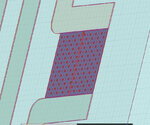Ata_sa16
Full Member level 6

- Joined
- Mar 29, 2016
- Messages
- 343
- Helped
- 59
- Reputation
- 118
- Reaction score
- 58
- Trophy points
- 28
- Location
- Milky Way Galaxy, 179° 56′ 39.4″
- Activity points
- 2,221
Follow along with the video below to see how to install our site as a web app on your home screen.
Note: This feature may not be available in some browsers.












I made like this to make it more realistic. now I have to put ground and my terminal in 1 port. This time, my problem is I dont now how to define it !
Finally I set it up like this. I do not know if it is correct or not.



12 hrs simulation and it is kind of stock
There are many ways to setup an EM solver wrongly, so even guessing about the reasons seems pointless.Finally, wrong result -> Z11= 1.2 - 190j , imaginary part is negative !!!!
If you didn't confuse meters with millimeters, negative reactance means capacitive load = no connection between port and coil.I defined lumped port as shown in figure below.




. I think HFSS does not calculate coupling between wires.

